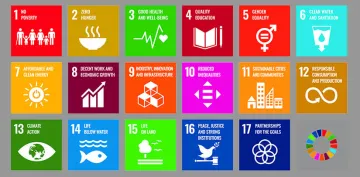Organizing the Foundation
Finding Funders
The SELCO Foundation was fortunate to begin operation at a time that international development and sustainability goals were merging, bringing new interest by private and government entities to efforts providing DRE solutions in development efforts.
The most visible impetus came from the United Nations Sustainable Development Goals (SDGs). In the 1990s, the United Nations had sponsored conferences concerning children, nutrition, human rights, and women to gain coordinated action on these issues among countries. These meetings led to the proclamation of eight Millenium Development Goals to be achieved by 2015. A separate set of UN conferences had been held concerning the environment. At the Rio Summit in 2012, world leaders decided to marry the two streams of work to create a unified set of aspirations aimed at providing long-term development that respected the environment. The UN’s SDGs became an international standard that influenced the efforts of governments, businesses, and the non-profit sector.
The SDGs aligned closely with the SF’s manifold aspirations, making the new organization an attractive partner for a variety of entities. Funders were also drawn to Hande’s reputation. His work at SELCO India had attracted widespread attention and he had been awarded numerous prizes for his efforts.
Nonetheless, SF’s approach required time and Hande looked to attract patient funders that would allow the new organization to develop its methodology based on trial and (inevitable) error. The Lemelson Foundation, a foundation that had helped capitalize SELCO India, stepped forward to provide initial funding for SF. Additional funds came through a variety of sources in India and internationally. In time, as SF’s interventions started to work, other funders came to support the enterprise. Moreover, the Foundation developed a reputation of being a thought leader on issues of user-designed, sustainable development.

The United Nation's 17 Sustainable Development Goals - many of which aligned with the SELCO foundation's mission.
Staffing Challenges
Early on in its growth, SF faced human resource challenges. The Foundation initially employed specialists in DRE or people with experience in specific functional areas such as health or agriculture. Many had done previous work in development. Hande thought that these people would come to adopt SF’s more expansive definition of interventions. However, many of these hires proved uncomfortable working with SF’s broad-based view of user-centered, ecosystem interventions. Hande noted, “I think the way we chose people led to project-based thinking rather than an ecosystem-based thinking… The education system, unfortunately, teaches everybody, everything in silos.”
To build the kind of ecosystem approach he favored, the organization began hiring people from varied backgrounds who were more practiced and comfortable with system thinking and looking at a problem through a number of lenses simultaneously. Hande contended, “Our interventions had to be crosscutting, whether you crosscut between finance, technology, architecture, business modeling, you could not be an expert of one but master of everything. We wanted to get away from project-based, program-based thinking and find people could think at a systems level.” The Foundation began to look for and find hires from a variety of backgrounds such as architects, social workers, designers, and engineers; individuals who would embrace the complexity of the Foundation’s interventions. Finding the right people remained a persistent challenge. Nonetheless, by 2023, the Foundation employed over 150 people.
Organizing the Work
The user-centered, ecosystem approach to DRE could be employed in a number of different areas. To organize its efforts, SF defined four ‘verticals’ - Livelihood Promotion, Healthcare, Education, Household & Community Wellbeing. These verticals allowed the Foundation to build domain-specific knowledge within important areas for development. The Livelihood Promotion vertical was further differentiated among the various types of microenterprises in which the Foundation would pursue interventions: Agriculture, Animal Husbandry, Micro-Businesses, Crafts and Textile, and Cooling. Mapped onto these verticals were Foundation staff who became regional experts with knowledge of local institutions and organizations that would be useful in ecosystem building.